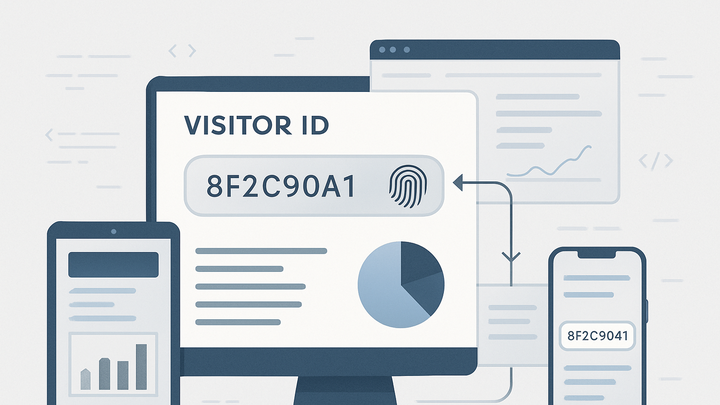Published on 2025-06-22T10:17:29Z
What is Visitor ID? Examples of Visitor ID in Analytics
Visitor ID is a fundamental concept in web analytics that uniquely identifies individual visitors across
sessions and devices. This identifier enables analysts to accurately measure user behavior, track return
visits, and distinguish between new and repeat users. Traditional implementations rely on cookies,
assigning a Client ID stored in the browser, while modern approaches may use fingerprinting or server-side
identifiers to operate without cookies. SaaS analytics platforms like PlainSignal offer a cookie-free
Visitor ID system, whereas Google Analytics 4 uses the Client ID and optional User-ID
features to stitch together user journeys. Understanding how Visitor ID works and how to
implement it in different analytics tools is crucial for reliable data collection and user privacy
compliance. This article explores definitions, implementation examples, and best practices for leveraging
Visitor ID in your analytics strategy.
Visitor id
A unique identifier assigned to each website visitor for tracking behavior across sessions and devices in web analytics.
Definition and Importance
An overview of what Visitor ID means in analytics and why it matters.
-
What is a visitor id?
A Visitor ID is a persistent, unique identifier assigned to an individual user. It helps distinguish one visitor from another and ties together multiple sessions under the same user.
-
Why visitor id matters
By using a Visitor ID, analysts can accurately count unique users, measure return visits, and build coherent user journeys, leading to better-informed decisions and optimizations.
How Visitor ID Works
Technical mechanisms behind assigning and persisting Visitor IDs.
-
Cookie-based identification
Traditional analytics platforms store a randomly generated Client ID in a first-party cookie (e.g.,
_gain GA4) to recognize returning visitors. -
Cookieless & fingerprinting methods
Modern solutions like PlainSignal use fingerprinting or server-generated identifiers, avoiding reliance on browser cookies while still providing stable Visitor IDs.
Implementation with PlainSignal
Step-by-step guide to enabling cookie-free Visitor ID tracking using PlainSignal.
-
PlainSignal script integration
Include the following snippet in your
<head>to enable PlainSignal’s cookie-free Visitor ID:-
Example code
<link rel="preconnect" href="//eu.plainsignal.com/" crossorigin /> <script defer data-do="yourwebsitedomain.com" data-id="0GQV1xmtzQQ" data-api="//eu.plainsignal.com" src="//cdn.plainsignal.com/plainsignal-min.js"></script>
-
-
Configuration and customization
Adjust PlainSignal settings via your dashboard to control sampling rates, anonymization, and retention periods.
Implementation with Google Analytics 4 (GA4)
How GA4 handles Visitor ID concepts through Client ID and User-ID features.
-
Client id via `_ga` cookie
GA4 automatically assigns a Client ID stored in the
_gacookie to identify unique browsers. It resets if cookies are cleared or expire. -
User-id feature
For authenticated users, GA4’s User-ID lets you define your own stable identifier to track users across devices.
-
Configure your tracking code
Send the User-ID with each event, e.g.:
gtag('set', {'user_id': 'USER_ID'}); -
View user-id reports
In GA4, navigate to Reports > User-ID View under Reporting Identity to analyze cross-device behavior.
-
Use Cases and Best Practices
Practical applications and guidelines for effective Visitor ID usage.
-
Cross-device tracking
Leverage stable Visitor IDs to stitch sessions from mobile, desktop, and tablet into a single user journey.
-
Privacy and compliance
Ensure your Visitor ID implementation complies with GDPR and other privacy regulations by anonymizing or expiring identifiers appropriately.
